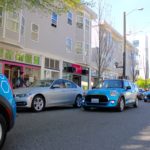BMW announced the launch of its ReachNow mobility service in a bustling Pike Motorworks showroom this past Friday. Highlighting a strong tie to Seattle and praising the city’s commitment to innovative transportation solutions, BMW Group Board Member, Peter Schwarzenbauer, and ReachNow Chief Customer Officer, Sandra Phillips described the platform as an answer to everyone’s mobility needs.
ReachNow spawned from a beta car sharing service that debuted in nine European cities, starting in 2011. “DriveNow” swelled to 600,000 users and led to 100 million miles of real-world testing data. From there, BMW partnered with RideCell, a Silicon-valley app developer, and the city of Seattle to launch a free floating car sharing service, followed by chauffeur services, long term rentals, and vehicle deliveries.
The initiative is one step in BMW’s Vision Next 100 plan to conceptualize the next 100 years of vehicle technology and design. “We want to continue to excite people about mobility, not just products,” said Schwarzenbauer. The company sees a beneficial, non-cannibalizing relationship between ReachNow and its traditional products. At this point, a number of other automakers have begun investigating similar services, but ReachNow gives BMW the jump on its competition.
I was given the chance to experience the service, discuss its unique proposition with BMW’s representatives, and ultimately decide if ReachNow is really an all-encompassing mobility tool, or merely a jargon-propped car sharing service.
Getting started
After downloading the ReachNow app, you’re greeted by a full-screen map and Uber-style slider on the foot of the screen. Adjusting the slider between BMW, MINI, BMW i, or “All” options updates the map with available vehicles. By selecting a model, you can preview its remaining battery life or fuel reserves, range, and reservation price per minute, but to reserve it, you’ll need to create a profile.
BMW quotes a registration process of just two minutes or less, all handled within the app. Simply enter your first and last name, phone number, address, and email to get a unique four-digit PIN via text or email. Next, you’ll need to enter your driver’s license and take a photo of yourself to validate. Finally, snap a photo of your credit card for future payments.
Related:
ReachNow debuts with 70 i3 models, 120 BMW 3 Series’, and 180 MINI Cooper Hatchbacks, for a total of 370 vehicles. Once you choose an available model and select the “reserve” icon, you can enter a destination, signal the vehicle, report damage, or cancel the reservation. The map also plots the course from your current location to the reserved vehicle. BMW didn’t state whether canceling your reservation incurs a penalty, but you are allotted 30 minutes to locate the vehicle and initiate the drive before your reservation expires.
Taking the wheel
Once you’ve reserved and located your vehicle, it’s time to go for a ride. You can unlock and lock the vehicle’s doors from the app, though it takes a few seconds for your mobile device to communicate commands to the vehicle. BMW also sends a physical card to each registered user to perform the same functions by tapping the card on the windshield-mounted sticker.
Before you can set off, BMW requires a few more steps to initiate the reservation, all performed within the vehicle’s infotainment system. After moving beyond the ReachNow welcome screen, you’ll need to enter your unique four-digit PIN (found within the app menu). If you’ve entered a destination through the app, you’ll be asked to start route guidance. Otherwise, simply select “start the trip,” to get moving.
Only after you follow these prompts will you be allowed to start the vehicle. One thing I learned from an uncharacteristically warm Seattle Spring day is that if it’s your first time navigating the process, you’d better leave a door open so you don’t overheat; air conditioning is reserved for those who follow directions.
Once the reservation has begun, the app will record your drive time, billing at a rate of $0.49 cents per minute of operation ($0.41 cents per minute during ReachNow’s “introductory period) or $0.30 cents per minute when the vehicle is parked. If you’ve reserved a BMW i3, critical information like nearest charge stations and range are displayed prominently on the driver display and infotainment system, while the petrol-powered MINI and 3 Series are business as usual. Fill-ups are included in the service, but better yet is that BMW has secured free parking at all meters in Seattle.
What’s different?
BMW calls ReachNow “the first holistic mobility tool in the car sharing space,” but the vast majority of its distinguishing features have yet to be released, so how do we evaluate its unique proposition?
A good place to start is by assessing how BMW laid the foundation of its services. The RideCell platform on which ReachNow is based is deeply innovative. Instead of merely building an app for any given city, RideCell tailors its service to the environment, infrastructure, and regional laws. “RideCell thinks about integrating into the fabric of a city, not just layering our platform on top of a community,” said RideCell CEO Aarjav Trivedi.
Beyond the platform, BMW worked extensively with the city of Seattle to roadmap operations for years of collaboration. “Providing affordable, connected, sustainable transportation options is what we’re all about here in Seattle,” said Deputy Mayor Kate Joncas. That attitude and the openness to ReachNow’s free floating service prompted BMW to invest in Seattle as opposed to, say, San Francisco, where there are several obstacles to this level of mobility service. ReachNow will eventually be available in at least 10 major cities in North America, and Seattle is a shining example of what can be accomplished through similar partnerships.
And speaking of mutually beneficial ideas, BMW spoke briefly of its plan to offer MINI and BMW customers the chance to list their own vehicles for rent on ReachNow. Not only do owners benefit by monetizing their cars while out of town, BMW benefits from an expanded fleet of vehicles.
Finally, BMW has given a unique opportunity for average consumers to experience electric vehicles. Though ReachNow’s fleet contains a minority share of i3’s, the limiting factor is charging infrastructure. “As consumer demands for electric vehicles become more clear, we will work with each city to grow charging options,” said Schwarzenbauer. “We believe this service will help promote electric driving, to overcome the stigma that electric driving is boring.” At this point, most people will have to buy or lease an EV to experience “living” with one, but through ReachNow, and especially for longer-term rentals, urban dwellers will have the opportunity to drive and judge electric cars with no strings attached.
Mobility 2.0
“This is mobility 1.0 – the starting point to get to all these other services,” said Phillips. “I see the future, mobility 2.0, as broader exposure of this service, fulfilling all mobility needs for customers on a global scale. Whatever customer feedback we receive will be fed into what we develop next – the vehicles, the infrastructure, etc. We want to meet mobility needs as they develop, so in some ways it’s hard to predict what needs might arise over time.”
Related:
Sure, you need to cut through the marketing language to get to the heart of what BMW’s doing, but the underlying approach is solid. Though the company claims there’s little competition between its mobility service and traditional products, initiating a program like this is still a leap of faith, especially at a time when vehicle sales are surging.
Being first among its peers to introduce a more holistic mobility platform gives the company an opportunity to learn what consumers really want and need out of service like this, and to adjust its approach based on those insights, before rivaling services ever hit the market.


















